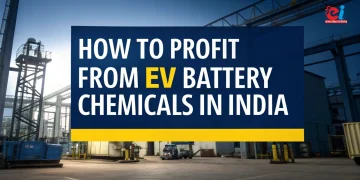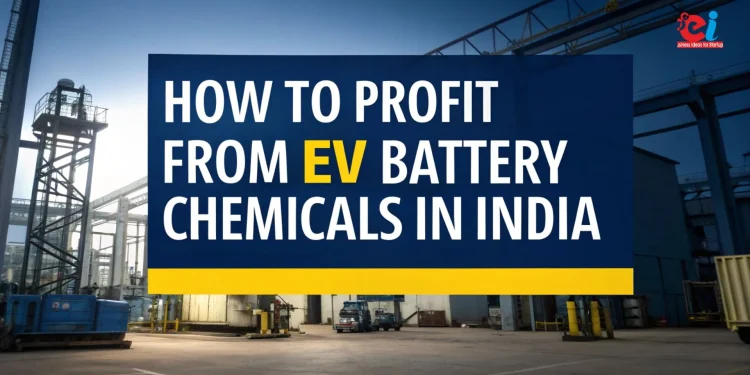Electric Vehicle (EV) technologies are profoundly transforming India is home to an EV Battery Chemicals ecosystem which is changing rapidly driven by initiatives of government, technology adoption and environmental challenges. The emphasis has mostly been on the battery packs, motors, charging infrastructure, however an equally important element powering this revolution is the chemistry of the battery, the electrolytes and additives.
These crucial enablers augment the functioning of lithium-ion batteries ensuring they operate efficiently, safely and with durability. As per Chemical Weekly, June 3, 2025 issue, considering India aims for 30 percent EV adoption in the country by 2030, there is an unprecedented opportunity for chemical MSME entrepreneurs in India’s EV revolution to exploit this niche yet important electrolytes and performance-boosting additives market.
Additives and Electrolytes
Additives and electrolytes are inclusive of salt bridges, membranes and metals which serves as a means of to transport lithium ions between the anode and cathode. Most commercial lithium salt batteries use organic solvents with lithium salts which leads to formation of conductive electrolyte.
Key Components:
- Solvents: Ethylene carbonate (EC), dimethyl carbonate (DMC), diethyl carbonate (DEC)
- Salts: Lithium hexafluorophosphate (LiPF₆), lithium bis(fluorosulfonyl)imide (LiFSI)
- Additives: Vinylene Carbonate (VC), Fluoroethylene Carbonate (FEC), and lithium nitrate as well as other compounds that improve safey, cycle life, and performance.
The Importance of Electrolytes in EV Battery Chemicals
- Battery Performance: Optimized electrolytes assist in improving thionic ease and increase charging speed.
- Thermal Stability: The risk of thermal runaway is controlled with the use of phosphates or fluorinated compounds.
- Lifecycle Enhancement: Additives create SEI layers which help in slowing the degradation.
- Cost-effective: Increased replacement intervals of the battery due to advanced formulations of electrolytes lowers the overall cost.
Shift in the Market and Rise in Demand
- The demand for lithium-ion batteries in India is expected to reach 260 GWh by 2030.
- Electrolyte costs account for roughly 10–12 percent of the costs incurred for manufacturing the battery cell.
- The demand for disodium heptaborate hydrated salt electrolytes in India will surpass ₹18,000 crore by 2030.
- The market is currently import dependent with China, South Korea, and Japan providing over 90% of the total electrolyte formulations.
Related: Starting a Lithium-Ion Battery Assembly Business
Opportunities in Entrepreneurship Related to Manufacturing Electrolytes
1. Solvent Blending and Formulation Units
- Goals: EC, DMC, EMC, and other mixed custom solvent blends
- Infrastructure: Reactors, agitated under glass, equipped with inert gas, distillation, stainless steel drying units fitted with
- USP: Provide electrolyte solutions customized for India’s temperature and grid conditions
2. High Purity Lithium Salt Manufacturing
- Focus: Fluorination and purification technologies for LiPF₆, LiFSI, LiTFSI production.
- Challenge: Moisture sensitive processes demand a glovebox and ultra-dry handling systems.
- Opportunity: Government support for local schemes on boosting battery chemistry headquarters.
3. Additives Production Facilities
- Scope: FEC, phosphazenes, lithium difluoro(oxalato)borate (LiDFOB) and vinylene carbonate (VC)
- Importance: Enhances functionality, safety, cold weather, and charging performance.
- Innovation: Indian startups can focus on designing pathways towards bio-based or less toxic additives.
4. Contract R&D and Toll Formulation
- Model: Provide battery makers with a dosage form QC and pilot scale testing of cell assembly.
- Demand: Relevant especially for Advanced Chemistry Cell (ACC) PLI scheme related participants.
- Infrastructure: Uses small pilot plants, equipped with HPLC, Karl Fischer, conductivity, and other testing facilities.
5. Battery Grade Solvent Recycling
- Idea: Retrieve EC or DMC from spent batteries and purify them.
- Business Model: Batter recyclers and “second life” battery profit from decreased waste and post-dependence import.
Key Startup Advantages
- Import Substitution: Dependency east of sea imports can be further reduced to save in the Indian economy.
- Customization: Formulations designed optimally for Indian road conditions, ad India’s temperate set by monsoon, fever, and winter.
- Export Potential: Cell manufacturers around the world are searching for trustworthy suppliers of electrolytes outside of China.
- First-Mover Edge: There are only 2-3 companies in India that produce lithium battery additives for batteries locally.
Related: EV Components Manufacturing Revolution and Battery Recycling Startups Boom
Technological and Manufacturing Requirements
- Maintained at a minimum of cleanroom level 1000 to 10,000
- Stainless steel reactors and jacketed vessels
- Nitrogen blanketing systems and vacuum drying ovens
- Pharmaceutical grade supply chains for silicon-doped line raw materials.
- Analytical tools: Conductivity meters, ICP-MS, HPLC, and GC
Policy and Funding Support
- PLI Policy for ACC: 18,000 Crores dedicated fund with goal for domestic content.
- Set up India and BIRAC Grants: For development sponsored research in developing green electrolyte R&D.
- FAME II & III Subsidies: Increase Supply of materials used for EV batteries and Electric Vehicle.
- Other State Policy: Propose for fund to supply units in the state of Gujarat, Tamilnadu, Maharashtra.
Emerging Trends and Innovation Levers
- Sodium-ion and LFP chemistry
- LLZO and LISICON solid-state electrolytes
- Phosphate ester flame retardants
- AI-powered QC prediction algorithms and formulation for Electrolyte design.
- Green chemistry and bio-derived solvents
Case Studies
- Elofic Industries: In partnership with international companies to set up the production of battery-grade chemicals.
- Altmin: Specializes in sodium-ion technologies and it’s compatible additives.
- Fluorochemicals Ltd: Increasing LisiF production with a continuous flow of fluorination.
Startup Challenges
- SOPA clearance or license for using hazardous materials and fluorinated parts.
- Subject-Matter Experts And Practitioners In Electrolyte Chemistry
- The capex cost of ultra-pure processing and QC infrastructure.
- Insufficient supply of one or more precursor chemicals.
Possible Scenario
- India is projected to have 8 to 10 Giga factories by 2030 and each will need captive or near electrolyte suppliers.
- Growth of electrolyte market: more than 20 percent on between now and 2030.
- Startups have opportunities in sweet spot additive chemistries from localized formulations.
- Business models based on recovering and reusing electrolytes will emerge.
Final Words
India’s EV future rests on the unseen shoulders of electrolytes and additives. Chemical entrepreneurs have the opportunity to build high-tech, green businesses as India increases EV adoption.
Limiting factors of salt production, additive invention, or formulation services by MSME’s and other startups are restricting the expansion of the EV value chain, which stand to further enable India’s clean mobility revolution.
About NPCS
NPCS, or Niir Project Consultancy Services, specializes in providing Detailed Project Reports (DPRs) and Techno Economic Feasibility Studies alongside Industry-Specific Market Research for ventures centered on EV and battery technologies. NPCS supports entrepreneurs by advising on the establishment of chemical facilities, securing subsidies, and guiding them from pilot to commercial stages, helping India transition its energy systems project by project.


























